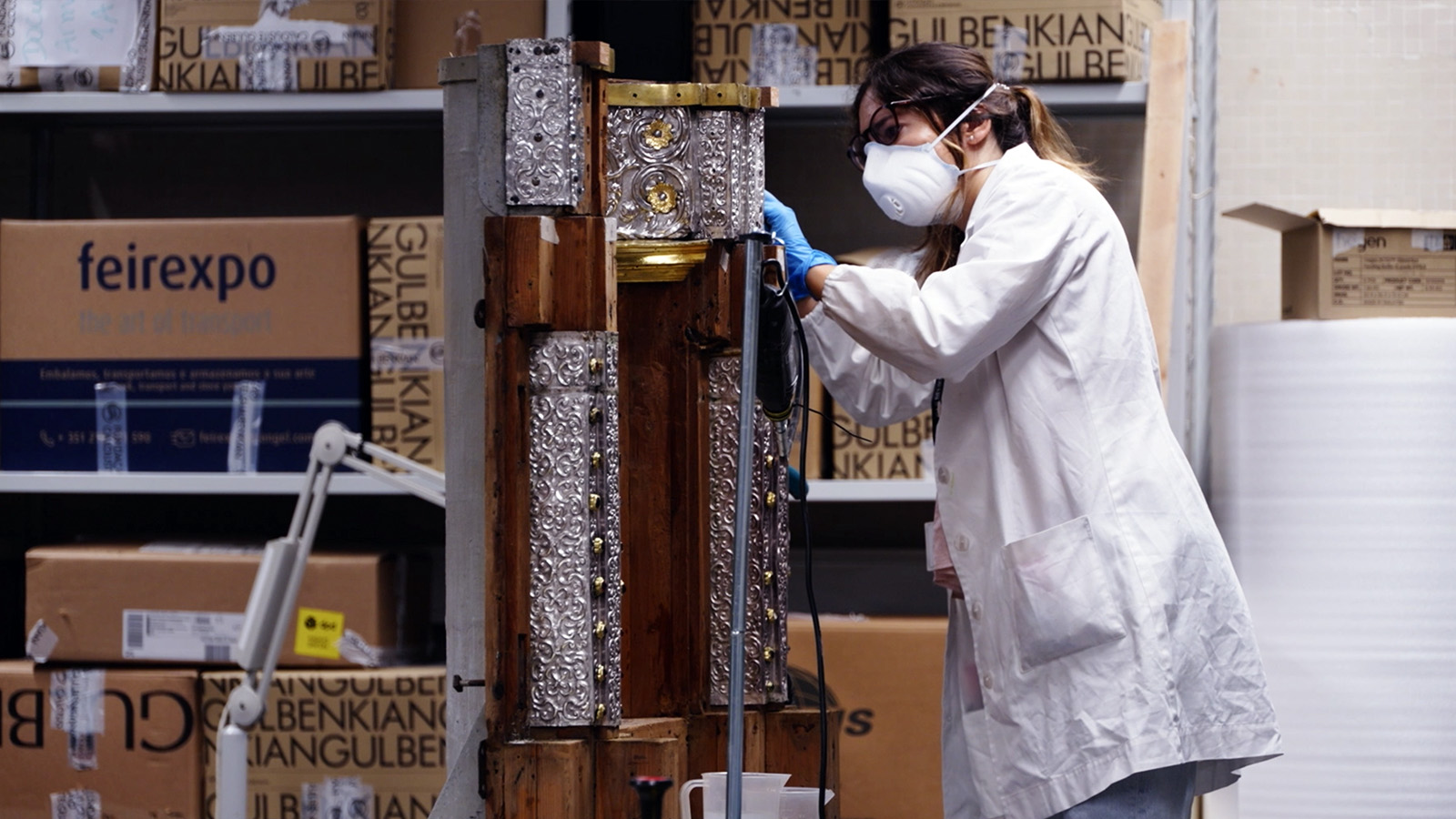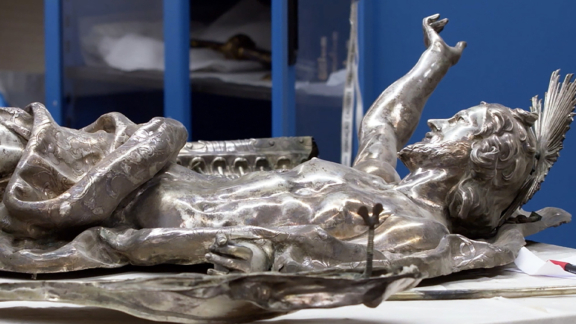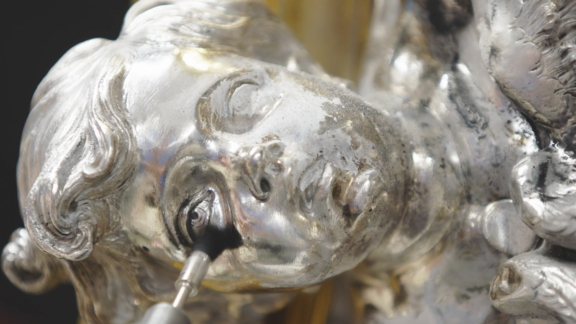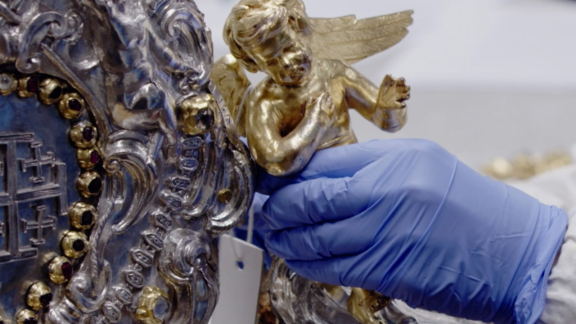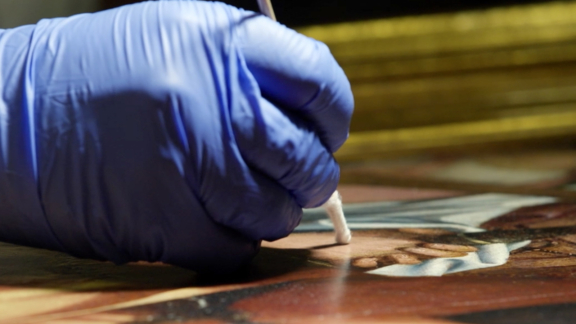Preserving a Universal Heritage
The Conservation and Restoration Project of Works of Art from the Terra Sancta Museum
The exhibition Treasures from Kings. Masterpieces from the Terra Sancta Museum provided the perfect opportunity to develop a complex conservation and restoration project for a group of works comprising silverware, furniture, textiles, paintings and graphic documents. The works in question – with the exception of two paintings from the Museu Nacional de Machado de Castro – belong to the collection of the Custody of the Holy Land. After being displayed in various international exhibitions, they will return to Jerusalem, where they will be presented in the historical section of the Terra Sancta Museum, which opens in 2026.
In April 2022, in preparation for the exhibition, a team from the Calouste Gulbenkian Museum travelled to Jerusalem to select the works and carry out a condition survey. Following this trip, the Gulbenkian Museum took responsibility for defining the intervention criteria and practical execution of these measures, along with the Custody of the Holy Land.
A collaboration was also established with José de Figueiredo Laboratory, to provide technical and scientific coordination during the conservation and restoration of the silverware. This partnership, fundamental for the success of the project, also allowed further investigation and analysis, with the aim of identifying materials and their altered compounds and, as a result, to support decision-making in terms of the methodologies to be implemented.
The 75 works from the Holy Land arrived in Portugal in the second quarter of 2023, at which time the conservation and restoration of a group of around 40 pieces commenced. This restoration project lasted around five months.
The relief Resurrection of Christ , dating from 1736 and originating in the Kingdom of Naples, is one of the most impressive works in the exhibition. A large and heavy piece (160 cm tall, 197 cm wide and weighing around 200 kg), it was the most logistically challenging, from its removal from the wall of the Latin chapel of the Apparition, in the Basilica of the Holy Sepulchre – where it was displayed for worship – to its installation in the exhibition.
The relief is composed of a wooden structure on which five cast silver plaques are mounted. The metal presented some darkening, resulting from corrosion and a build-up of dirt and cleaning products from earlier interventions. Structural damage was also observed, particularly on the lower part of the frame, including deformation, cracks and losses in the material.
The restoration began with the dismounting of the work, along with the mapping and labelling of each piece, which facilitated the final assembly process. Next, all the elements were cleaned chemically or mechanically, the structure was reinforced and the deformations corrected. The entire intervention process was rigorously photographed to provide a documentary record of the work carried out.
Another striking work of great artistic quality is the altar frontal from Naples, made in 1731 by the silversmith Gennaro De Blasio. Composed of three panels connected by iron hinges, the central panel of the frontal presents the theme of Pentecost, while the side panels show the Franciscans Saint Louis of Anjou and Saint Bonaventure.
The friezes and various three-dimensional elements of the work – including the sculptures representing the Virgin, the Apostles and the Franciscan saints – were removed for cleaning, thus allowing full access to the object.
The silver and gilt-copper elements were also cleaned chemically or mechanically. Part of one of the lower friezes, originally in gilt-copper, was missing, which disturbed the general reading of the work. To fill the loss, a new frieze was sculpted from wood and later gilded.
The eucharist baldachin offered by King Philip IV of Spain and his son, the future Charles II, proved to be one of the most demanding restorations of this large-scale conservation project. Made in 1665 in Messina, Sicily, and received in Jerusalem in 1666, this sizeable work is split into two large structural elements which were joined together. The piece is almost entirely covered by a thin silver plate, abundantly decorated with ornaments in relief and with set coloured gemstones. The silver is applied to the wooden structure in hundreds of pieces, in a complex assembly scheme.
The elements that could be detached were labelled and cleaned separately. This was the case with the angels, which, after cleaning, were placed in an ultrasound bath (to help remove the cleaning products) and then dried. The silver, in addition to darkening and observable products of corrosion, was cracked and deformed, particularly at the edges. After the cleaning, the application of structural reinforcements and the correction of deformities, all the pieces were returned to their original places, using the original fixings where possible.
This exhibition also features two sixteenth-century Portuguese paintings, from the collection of the Museu Nacional de Machado de Castro, in Coimbra, depicting The Discovery of the True Cross by Saint Helena and Emperor Heraclius with the True Cross.
Despite having undergone earlier restorations, both paintings presented unstable adhesion of the preparation layer and the chromatic layers to the wooden support, already showing small losses. The intervention involved stabilising the paintings by fixing the polychrome where it had become detached. In addition, the losses were filled and chromatically integrated, meaning that their shape and/or colour was corrected. The tone of earlier integrations, which was significantly different, was also rectified. The treatment of the frames involved removing accumulated dust, filling and toning the losses of the gilding.
Finally, it is worth mentioning that this project could not have been successful without the commitment of a multidisciplinary team composed of 12 conservator-restorers specialized in diverse areas, art historians, chemists and carpenters, among others. This exceptional artistic treasure is a work of universal heritage, and contributing to its preservation has been a source of great satisfaction and pleasure to all involved.
Treasures from Kings
The kingdoms of Portugal, Spain, and Naples made some of the most significant gifts to the Holy Land. In this video series, discover some of the objects and figures that played a leading role in these moments.

